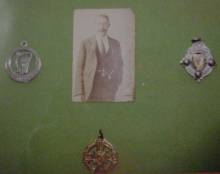
Tug-of-War
Between the 1920s and the 1940s, there was a tug-of-war team in Blackwood. The coach of the team then was Pad Martin from Inch. The team was trained in McGraths field at Han Kirwan's Cross.
To test a man for his strength, they would tie a rope to a crab tree growing in the field. Twenty-five kilograms was slipped along the rope. The man trying for the team then tried to pull the rope straight and lift the weight. The further away it was from him, the harder it was to lift. The team competed in Harrison's field, which is a famous hurling field.
Gerry Bergin has told us that he remembers the teams travelling in Bill Bowden's or Joe Doheny's lorry to Rathdowney. There was once a carnival in Rathdowney to raise money to build a new church. Gerry Bergin remembers them going drinking after competing. They would drink "Perry's Ale". This Ale was much stronger than the Smithwicks beer they usually drank. Many got very drunk afterwards.
These are some men who "pulled" (competed with the team) with Blackwood during those years:
Pake Dunne, (anchor man), Jim Butler, Joe Nolan, Tom Nolan, Ned Nolan, Bill Kyle, Paddy Bergin, Jim Bergin, Paud Bergin, Jack Bergin, Jack Delahunty, Paddy Obbins, Jack Obbins.
James Lalor 
The photo on the right shows James Lalor with his Leinster and
All-Ireland medals from 1905 and also a County Championship medal.
Source: Julia Lyons.
"One of the oldest of those who gained distinction with Kilkenny, when first this county forged ahead in inter-county hurling is Jim Lalor of Three Castles. Over 50 years ago in 1895, he first donned the jersey of his parish club and ever since, had remained closely connected with hurling in a very special way.
He was born at Cooleshall Three Castles in October 1877 and received his education at Clinstown National School. In 1895, he first played with Three Castles and in 1898, won his first County Championship medal with them. He also played with them in 1903 when this club won its second and last, County Championship. He played with the County team in 1898 when they were beaten by Tubridora and he recalls the many hard matches of this period when Kilkenny succumbed to Kilfinnan, of Limerick, on two occasions, and to Two Mile Borris, of Tipperary, not forgetting, of course, Cork - the ancient enemy - before they carried off the premier honours in 1904, for the first time.
One of the older school, Jim Lalor had retired from Inter-County hurling before Kilkenny began their great series of victories from 1909 to 1913, but he did play on the victorious teams in 1904, 1905 and 1907. He had the honour of captaining the Railway Shield team in 1905, and personally held the shield for twelve months until Tipperary claimed it the following year. He recalls the beautiful set of medals given with the shield, which were presented by the citizens of Kilkenny. He holds seven Leinster medals gained in 1895, 1897, 1898, 1903, 1904 and 1905.
His brother Martin, also played in the 1905 Championship and now living in Freshford, is famous for his hurleys, which are well-known and used throughout the country. His son Jack, also is a well-known player for Three Castles at the present......... ...........Hurling in Kilkenny in those days, was confined chiefly to three clubs - Mooncoin, Tullaroan and Three Castles - and it was from these clubs that players were generally selected to represent the county.
In 1905, however, the County Championship was won by Erin's Own - a comparatively new team - and this success gave hurling a much needed fillip in the county as well as widening the selection of players. Jim Lalor is of the opinion that the practice of selecting the greater part of a county team from one or two premier clubs is greatly to be deprecated, as it tends to lessen the interest of the weaker clubs in the game.
He never broke his connection with hurling and for forty-five years now, he has supplied the Central Council and major clubs of the country with hurling balls. This rather exacting craft was brought to perfection by Jim Lalor, and his handiwork is recognised in all parts as the very best. He has of late years retired from this trade, but his son is carrying it on with the same signal success. I believe that I am safe in saying that on every hurling pitch in Ireland, a "Lalor Sliotar" has at one time or another been played.
Known as one of the fastest sprinters ever to hurl in his day, Jim Lalor admits that the hurlers today are also fast, but, as he says - "there is no use beating your man to a ball then leaving it behind you!" The striking is by no means as accurate or as sure as of old and there is too much poking carried on when first time pulling should be the policy. Air striking is fast dying out altogether, he holds, and this he considers one of the most spectacular features of the game."
- This is an article written by John D. Hickey, the Gaelic Games correspondent for the Irish Independent. The article was written in the late 1940s.
James was also very interested in fishing and shooting. James cousin Martin "Roundy" Lalor, also played for Kilkenny in the All Ireland of 1922. James brother Martin's son Jack, also made hurleys for many years.
Northern Junior Hurling Final 1945
This poem tells the story of the 1945 Northern Junior Hurling Final between Lisdowney and St. Rioch's. The poem was given to Johnny Ivory by Joe Young, and Joe might have been the author.
Towards the end of a tough and at times, rough game, St. Rioch's scored a disputed goal to take the lead for the first time. Shortly afterwards, as the referee was about to award a free to St. Rioch's he was struck by a supporter. A free-for-all developed, in the midst of which the sliotar disappeared.
A stranger who had attended the match said later to Joe Young that he could only compare it with " The Battle of Benburb" which he had just seen re-enacted by the Irish Army at a military tattoo in Phoenix Park. The County Board investigated the match and decided to award the match to St. Rioch's because a Lisdowney supporter had struck the referee. Lisdowney delegates argued that the supporter in question was not a member of their club or, indeed a Lisdowney man. The Chairman, however, said that he himself had been collecting on the gate and had seen him carrying in the Lisdowney jerseys. Case closed.
A certin Lisdowney supporter questioned the need for all the meetings and enquiries, especially with petrol so scarce, saying: "You'd think it was one of them new bombs that fell below Jenkinstown." (He was referring to the atomic bombs which the Americans had dropped on Hiroshima and Nagasaki).
The final word on this game must go to that wise man of hurling, the late Fr. Kearns. He had taken the newly appointed parish priest of Ballyragget, Fr. Comerford, along to seen the match. When asked what the new man thought of it he replied: "He took a poor view of it."
The Lisdowney Team that played that day, as recalled by Johnny Ivory was:
Neddie Purcell; Tommy Butler; Tom McEvoy; Packe Walsh; Micky Grace; Joe Young; Bill Campion; Martin McEvoy; Jack Walsh: Ned Wall; Marcus Butler; Dick McEvoy; Jimmy Phelan; Billy Fogarty; Ned Doyle; Micky Ivory.
Lisdowney Versus St. Riochs
Lisdowney and St. Riochs were matched
For the junior Hurling Crown
On the fourteenth of October, And the venue Jenkinstown
With the hay and the Harvest in
Through months of heavy toil,
We thought we'd have a holiday,
And so I said to Doyle,
"Go tacke up the pony, Tom,
And see if those young city lads
Are as good as what they claim."
We had read it in the papers
That they left no stone unturned
And their running for the final
Had the Fair Green almost churned.
In spite of all the rationing
They had olive oil galore
And their trainers and their runners
Said their hands were really sore,
So sure they were of victory
Like kids building sand
They made a song, set to the air
Of McNamara's Band.
I knew myself the local lads
Were working day and night,
And couldn't think of hurleys
Yet every one of them I knew
And I was satisfied,
Before they would bow to any team
There'd be trouble multiplied.
We hitched the pony to a stake
Inside the entrance gate,
And when I saw the crowds
I thought we were too late.
But no, the teams had just lined up,
And the backs went back.
There was a cheer all round the field
As ash on ash did clash.
Our lads, it was soon plain to see,
Were pressing for a score,
And the white flag sailed
As we loudly called for more.
All through the game they kept it up
And never once did slack.
The forwards, the centre field
The goalie and full backs.
And then the ref called off the match,
Our lads were not to blame,
For win or lose, or even draw,
They can take it just the same.
Doyle groaned, and looked at me
And said: "Begor, it is great weather
The only thing we rue today
Is the shortage of sewn leather."
Wellbrook Hurling Club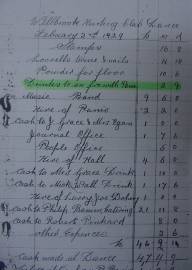
This Cash Book from the Wellbrook Hurling Club (1929) shows some
of the club's expenses in 1929. Expenses included twine and nails, powder for
the floor, the band (£9. 5s. 0d), hire of a piano (£2. 2s. 0d.).
The expenses also included "Drinks to and fro with piano"!
Source: Peggy Hamilton.
Dancing
There were a few house dances during Christmas but in Freshford, the parish priest put a stop to them. Some good places were Byrnes. Mr Byrne put in a cement floor and when it was polished it was very good for dancing on. The Pattern of the Dinan was held each year on the last Sunday in July. It went on for a long time but then the dance board started in Three Castles. The Pattern was held in a field behind Campion's pub. Everybody cycled from Freshford, Lisdowney, Kilkenny, Conahy, Gathabawn, Balleen and Tullaroan.
A few times they put up a tent but it was no good because when you were going home it was so dark you could not get your coat and sometimes, the tent fell. The dances were on from May to September. Every Sunday night all through the Summer, people walked to the dancing board in Three Castles. People in the area went down the Moneenaun Road which was a great short cut. The dancing went on from 7.30 to 10.30. It cost 1/= to get in. A band played on stage which was erected for the occasion. Everybody had a great time.
The Pattern of the Dinan came back for a while. There were lots of stalls with sweets and "loop the loop". There were dances in Dunmore at Guilfoyles. Music was played on accordions. Jack Dooley, from Suttonsrath, and Phil Treacy's three-man band from Kilkenny were the favourites.
Some of the dances were waltzes, fox-trots, half sets and tangos.
The favourites were "Excuse-me" and "Paul Jones". Excuse-me was when you would
be dancing with your partner and someone else would come up and tap you on the
shoulder and the girl would have to go with that boy. Paul Jones was where the
girls were in a ring in the centre and the boys on the outside. The music would
start and stop again and the girl had to grab a partner.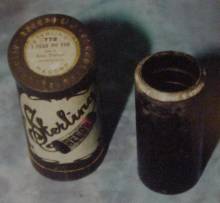
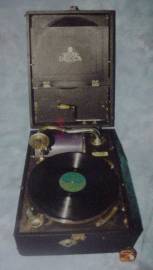
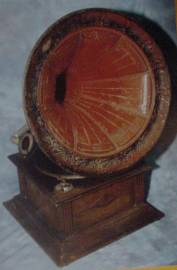
On the far left is cylinder record and its container. It is
over 100 years old and it was played on a phonograph.
Beside it is a Pathé-phone. It is a type of old gramophone with a horn.
It played records called 78's. It was driven by a spring and the spring was
wound by a handle. On the right is a Decca gramophone. It is about 90 years
old. It was wound by a handle which is clipped into the lid. The handle was
placed into a hole at the front. There is a small box of "His Master's
Voice" needles in front of the gramophone.
North Kilkenny Hunt
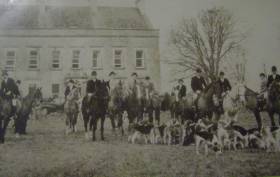 This
is a meeting of the North Kilkenny Hunt at Ballyconra House in 1953.
This
is a meeting of the North Kilkenny Hunt at Ballyconra House in 1953.
Source: John Hickey.
A public meeting was held at the School House, Freshford on the 30th of March, 1931, to agree on a proposal to form a pack of hounds to hunt Castlecomer and Freshford. The Northern end of Kilkenny Hunt's ground was known as "Freshford County". In 1931, Major McCalmount retired from hunting this ground of Co. Kilkenny. After he left, a new pack of hounds was formed. They were known as Mr. Alexander's hounds because Mr. John Alexander was master of the hunt and also huntsman. The hounds were kept at Uppercourt, Freshford.
In 1934, John Alexander was succeeded by Captain Bramwell for
whom the hunt club built new kennels at Ballyragget House. The years 1935 and
1937, Mr George Angel was in office. He then in turn, handed down to Lord Kildare
and Mr. R. Prior - Wandesforde. This joint Mastership lasted until the war when
a committee took control of the hounds for one season, Captain McCheane being
master and his wife was assistant master. The secretary for ten years was Mr.
R. Cahill.
In 1940 and 1941 it seemed to be the end for hunting in Ballyragget. However, Rev. John Kearns C.C. was determined that the hounds would be kept for the young farmers of North Kilkenny. A new committe was formed with Jack Murphy and Jimmy Campion as joint masters, Mick Pheland as huntsman and Michael O'Reilly as hon. secretary. There were difficulties which were to come for the new hunt. Father Kearns left for Africa in 1945 and in the same year, the kennels were taken over by the new owners of Ballyragget Estate.
It again seemed over when Mr James Dillon of Tullaroan came to the rescue by offering temporary kennels. The hounds remained at Tullaroan until 1947 when the present kennels were bought by the hunt committee.
On the right is an invitation to a North Kilkenny Hunt Dance held
at Ballyconra House on Tuesday December 31st, 1935.
Source: John Hickey.
The North Kilkenny Hunt
by Martin O'Hara
I was going to 'Comer a short time ago,
For a load of good coal to keep the homefire aglow,
When all of a flash, right around the mare wheels,
And under the car sure she danced jigs and reels
Now to tell you the truth, I near died with the fright,
And the mare kept on dancing till with froth she was white;
"T'was the cry of the foxhounds that caused such a stunt,
And for the first time I saw The North Kilkenny Hunt.
Captain Branwell, The master was first in the chase,
Sure I pitied the horse, for he is a hard case;
Barbed wire or thick hedges will not keep him back,
Faith! by hook or by crook he will keep up with the pack.
Fred Dimmock, the first whip, then came like the wind,
And Paddy Regan, the second was not far behind
Captain Wandesforde, on Jeremy, then went to the front,
And I wished him long life with North Kilkenny Hunt.
That great horse called Goblet, with brave Dr. White,
At the races once brought me a few "bob" all right,
So I wished him "good-luck" when they passed me that day,
And for poor Doctor Farrell then I shouted "Hurrah!"
Ned Hogan next came, sure as gay as a lark,
On amother good thing, though it was not Red Park,
Next came a fat pig through the ditch with a grunt,
He was out for a day with North Kilkenny Hunt.
- ( This poem was written about 1932 and published in the Kilkenny
Journal".)
Source: - John Hickey.
Fishing
Fishing was a hobby many people were interested in in the 1940s. Jack Hamilton told us that fishing back then, was great fun. His friends and he would all meet and go fishing. Salmon and trout were plentiful. The fishing rods were made of greenheart and lancewood. These rods would be about 12 or 14 feet long. The cast was made of catgut. The fly-fishing line was made of hemp and the reels were brass. The bait people used were worms, flies and devons. A spoon bait was used for catching pike.
When a fish was caught you would gaff it out of the water. The salmon would be taken into Kilkenny where a hotel might buy them. If a fish weighed 10 pounds your would get about £2 or £3. After a day of fishing sometimes the fishermen would have a meal on the river bank with cooked fish. The police man of the river was called a bailiff. Some of the best fishermen on the river at that time, were Mick Thornton, "Spooly" Butler, Peter O'Neill, and Fr. Timothy.
Peter O'Neill once dived into the River Nore in February to get back his spinner because it had stuck in a branch. Spinners were so dear back then that it was a case of having to. It was his last spinner.
Poaching was popular then but it never affected the salmon stock because they only took a few. Poaching for eels under a bridge was something every fisherman knew. You would do it with a 4 foot long ash plant with a
split on top. In the split a hook and worm would be placed. That was then stuck in between the stones under a bridge. The eels stayed in the cracks between the rocks. You would stand in your bare feet underneath the bridge.
Jack said that often the eels would wrap themselves around your feet when you pulled them out and you would falls down. Another way of poacing that was sometimes used was to put a stick of gelignite in a tin and throw it into the river. There would be net across the river 5 or 10 yards down from the tin. When it exploded the fish would get caught in the net.
Jack said that while fishing every fisherman had good manners. They would never cross in front of another person while they were fishing.
Going fishing. On the left is a young Jack Hamilton with Jack and Han Kirwan and Jim Lee.
On the right is a group of fishermen on the Nore about 100 years
ago. 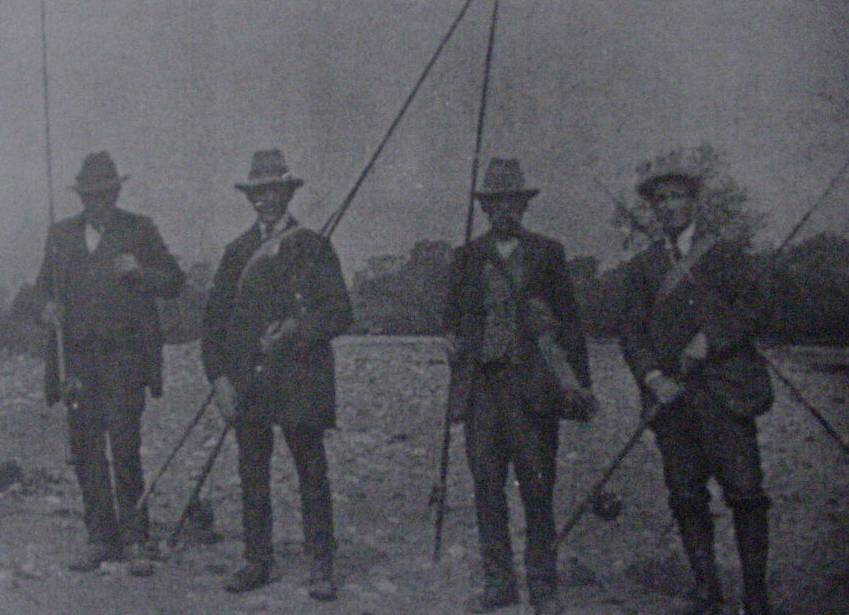
Bobbing for eels
Jack remembers that eels were very plentiful in the river in those days. Sometimes they caught eels by "bobbing" for them. A small ball of wool thread was used on the end of a string. The string was attached to a long stick. Worms were threaded along the string to the ball of wool. When the eel took the worms the wool thread would get caught in its teeth. If you were quick enough you could haul the eel out onto the bank with one pull. You then had to get the eel before it made it's way back to the water.
There is an old story about Fr. Timothy and the bailiff. One day Fr. Timothy had two salmon coming back from the river when the season was closed. As he reached to road he saw the bailiff coming towards him. He slipped the two salmon into a horses cart that happened to be passing and walked along quietly behind the cart until the bailiff had passed on. When he was gone he took out the salmon and said goodbye to the farmer.
The next day the bailiff met him in Kilkenny and said: "Hello Timothy that was a sad funeral you were following yesterday."
Fishing Rods
Jack Hamilton told us that the wood used for fishing rods at the start of the century, was Greenheart and Lancewood. Greenheart was an Indian wood and lancewood was a Brittish wood that was like tough elastic and was good for fly rods. A Spiltcane rod was a fishing rod which you made by splitting the Lancewood and sticking the pieces together. There was a wire running throught the rod. These rods are no longer being sold for they are too heavy for the modern fisherman.
Years ago, the rods were made locally out of the shafts fo horses' carts. They did this because the shafts were made out of Lancewood. Tom Whitehead made the shafts and would make the splitcane rods if he was asked.
Playing Cards
Anthony Tallis remembers playing cards when he was a young lad. They travelled by bicycle. There was a card game at Jack Obbins house any night. A game of twenty five would be played. He also travelled to Ballyring to Danger Brennan's house with Mick Blanchfield, Dick Blanchfield, Pat Tallis and Jim Kavanagh. This house is now owned by the Mullally family.
Skittles
Skittle was a very popular game played at crossroads years ago. A very popular spot to play was Han Kirwan's Cross. This is how they were played. There were five skittles placed in a circle like this one. Players tried to score by knocking the skittles out of the circle. They threw, three large skittles called "pelters" at them. The pelters in diameter were 10" long and 3" wide. - The skittles were set out as shown in the diagram.
Short line
The circle was 3 feet 6 inches in diameter. In skittles the game was played
uo to 101 but your last score had to be one. To score, you had to knock the
skittles out of the circle. The "pelter" had to land inside the "short" line.
The skittle was 4" high by about 1" in diameter. There were three pelters.
A good skittle player could score 15 in one throw. He would knock out the centre row with one "pelter" and take the 2 ande 3 with the other two. The pelters were made of oak, elm or ash. You could throw about 20 feet from the short line. Two of the best players in the area were Neddy Kelly and Jack Cahill.